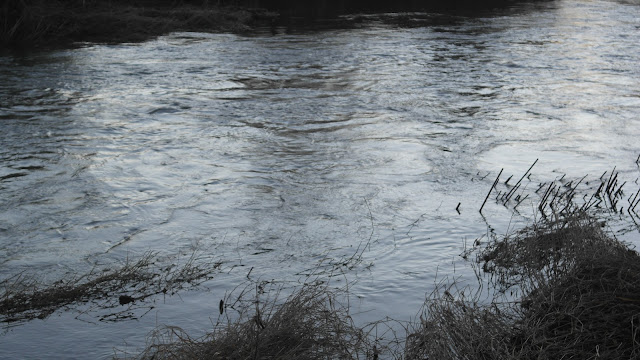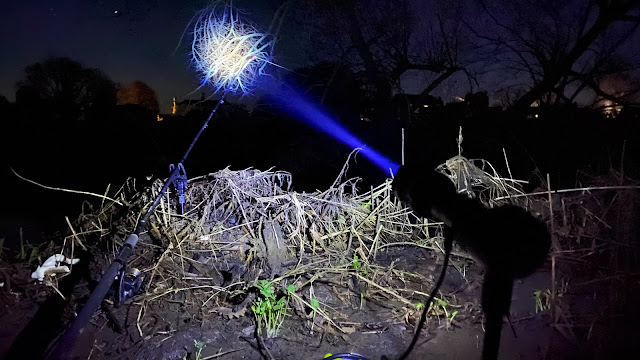When I received a scarf for Christmas from the company I work for a couple of years ago, I thought someone had forgotten to take the security tag off. A quick google of the designer John Sterner (never heard of him) theses scarfs don't come cheap, but no I was wrong, as it turns out the bright yellow tag is part of the design apparently.
Yeah, all very odd to me, but then having worked with many car designers over the years, these sort of things are not unexpected. I'm not a scarf man, but anything to keep me warm in these conditions is most wanted I must admit. Apart from my fingers from time to time, I've got all the gear now and cold doesn't both me any more. I'm just hoping Sam, my fishing partner in crime is up for a dangle soon, because I've missed my little fishing buddy I must admit.
With the rivers been up and in flood for such a long time now, needs must and it's just me fishing at the minute. Now there is something about a stretch of turbulent water that attracts spectators, but though many will stand and stare, not so many will think of fishing where the water is really rushing along. Perhaps they think it unfishable, perhaps they think it would not be worth fishing anyway, very often they would be wrong on both counts.
You see for artificial sluices and the like, it is rare to find a water so uniformly fast that there are no fish in it, there are always irregularities, large or small, on the bed or in the bank of the river, which deflect the main force of the current and create sheltered lies.
Sometimes, of course, there are very obvious likely spots where an obstruction of some size, and the division of the current above and below it, are visible at the surface, sometimes one can deduce the presence of irregularities in the shape of the bed by noting the pattern of the surface flow. The less turbulent areas can hold a surprising number of fish, and there are almost always lots of lies which hold a fish or two- behind boulders, bits of weed, sunken branches, and so on.
If the shelter was not there, there would be no fish. They are not given to roaming about such water in search of their food, continually battling against current. They prefer to wait for something to come to them. They may sometimes move up-current to intercept something, but they will not move far across the current.
This is not the type of water for any who seek restful contemplation, it means hard and continuous fishing. A stationary leger, unless it brings an immediate response, is not very likely to bring a bite at all, for a matter of 6 ins. one way or the other can mean that the bait is anchored in water which never holds fish.
In some conditions there can be a heavy but varying drag on the line, this causes excessive bowing, makes bite detection very difficult and he drags the bait about the water too quickly. I find it best to fish, as nearly as possible, upstream, holding the rod high to reduce the amount of line in the water.
This means that fast water can be fished without using a forbiddingly heavy lead. Occasionally, even in very turbulent water, little lead is needed. Though the water at the surface may be swirling wildly below a fall for instance underneath it may be quite steady, often with a nice, easy back current. Such places can, in fact, sometimes be fished perfectly well with no lead at all.
One simply has to find out by trial and error what is really necessary, bearing in mind that to vary the length or direction of the cast by a yard or so may call for a drastic adjustment to the weighting of the tackle. In turbulent water the bites are liable to vary from a tiny pluck to a rod-bending heave, and there'll be slack-line bites too.
The only safe course is to strike at anything which resembles a bite. This way you will inevitably strike at the knocks of weed and debris but you will also strike the real bites, as well. To attempt to differentiate between the two is to miss a lot of bites, unless you are much better at it than I am.
In general the larger baits are to be preferred, even if on other parts of the water small baits are generally used. Perhaps the speed of the water and the short time the bait is in view has something to do with this. There is very little water which is altogether too fast for fish, and if there are fish present there is a way of getting them out. It is rarely easy fishing; it may demand a drastic revision of tackle and methods; but it is undoubtedly fascinating, always challenging, and sometimes very rewarding. And who can ask for more than that?
Thankfully as the graph shows above, with the rain finally letting up the rivers are dropping nicely. It's still pretty nippy mind you with the daytime temperatures barley above freezing but at least that fishing fix can be had by choice, and not dictated to by the levels.
For this post work short session the stretch of convenience was chosen to try and winkle out a chub at dusk which seems to be the time they are on it here. With a little colour in the water still I was hoping they would be confident as well, after not knowing what the heck is going on with the rivers being all over the place. These are chub after all, their wanton gluttony fear no angler.
So yes it was out with the bread naturally, a veritable Chub catcher if there ever was one !!!
Before settling in behind the quiver rod in to dark though it was out with the trotting gear with some bread mash as feed to try and see if a moving bait would get them out from their lairs.
Bread like no other bait really, well maybe maggots get them in a frenzy when they are in the mood, when especially in the summer surface fishing with bread they cannot resist the white stuff, a little like the cocaine snorters from Scotland (Scotland has the highest level of cocaine consumption in the world), they need their fix.
Those bites came at dusk and the last bite that I missed the fish felt the point of the hook. I was using my AD John Wilson quiver rod and to be honest the tips are a little cumbersome, I could have used my TFG River and Stream set-up that is far daintier in comparison, I rarely miss bites on that because there is no resistance whatsoever.
Anyway, that swim went dead so it was on to the next one, after half an hour, nada, so on to the last swim I'd fish. The ground by this time was rock solid with the air temperature -1.
I was getting ready to get the gear in the car when after a couple of sharp taps the tip went all the way round and a fish was on. Nothing like what swims here sadly judging by the fight it was giving me, so when the 2lber surfaced I teased it in to the margins and unhooked it in the water. And that was that, no more bites sadly and after 2 and a half hours, not much to show for it.











0 comments:
Post a Comment